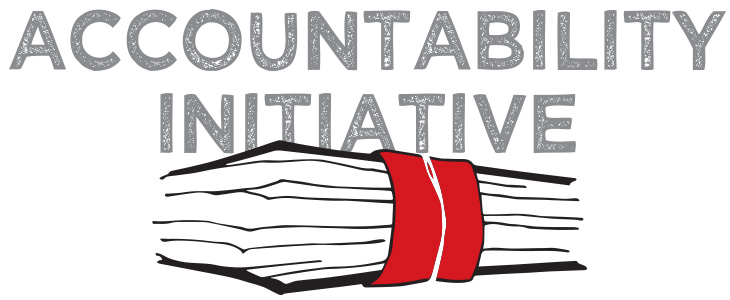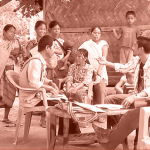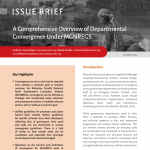
Understanding Local Dynamics and Tracking Fraud/Corruption in NREGS: Notes from the 2nd field visit.
4 May 2012
Continuing with our study on Social Audits in NREGS in Andhra Pradesh, I visited the Medak and Papannapet Mandals in March. The study aims to analyse the efficacy of the social audits as a platform to capture the universe of complaints and whether it leads to effective grievance redressal. My part in the study is to understand the local dynamics in the selected GPs and to track corruption and fraud.
Based on the data from the Society Social Audits, Accountability and Transparency (SSAAT) website, we selected Medak and Papannpet Mandals as they were the front runners in terms of total misappropriated amount in Medak district.
Within each of the 2 Mandals, we choose 4 Gram Panchayats (GP) broadly based on the following two criteria
- The various types of complaints and the sum of misappropriated amount across the Field Assistant (FA), Technical Assistant (TA), Additional Program Officer (APO) and Branch Post Master (BPM) cadres.
- The % decrease/ increase in the misappropriated amount from Round 2 to Round 3 of social audits.
Based on the above criteria we selected the following GPs
Medak Mandal: Magta Bhoopathipur, Nagapur, Madulwai and Jakkannapet.
Papannapet Mandal: Cheekode, Arkela, Kurthiwada and Narsingi.
In my previous visit to Medak and Papannapet Mandals in February 2012, we conducted a survey in the 8 GPs to capture the impact of social audit. More information about my previous visit can be found here.
This time, we wanted to dive deeper into the local dynamics and corruption/ fraud in NREGS at a Gram Panchayat. Though we were not able to uncover the ‘insider’s details’ about corruption and fraud, we did uncover some interesting information during this field visit. Some snippets from the field visit are below.
Tractor trips: In NREGS, small farmers, those who own 5 acres or less land, are eligible to receive black soil, free of cost under NREGS, to increase the fertility of the land. This is mainly targeted at the SC/ST communities to convert their infertile land for farming. The black soil is dug by the wage seekers at the work site and transported to the sanctioned farms. A tractor is assigned to each group of wage seekers for transportation.
Each trip should carry a load not more than 2.5 m3. The payment for tractor trips is based on the distance between the work site and the farm as shown in the table below.
| Km Radius | Rate Per m3 | Rate per 2.5 m3 |
| 1 | 58.5 | 146.25 |
| 2 | 68.25 | 170.62 |
| 3 | 78 | 195 |
| 4 | 87.75 | 219.37 |
| 5 | 104 | 260 |
So how are the funds misappropriated? The FA negotiates with the tractor owner about the per trip costs. By default, it is assumed that each trip would carry a ‘super load’, also known as ‘paper load’, (i.e, as much as they can) and for each trip, the payment is negotiated between Rs 80 to Rs 100, depending on the distance from the work site. Since there are many tractors and less demand, the tractor owners generally concede to the ‘revised’ prices set by the FA/TA.
Each group is assigned a tractor. The tractor driver is given a chit for each trip and at the end of the day the number of trips is noted down. Within 15 days, the payment is made. When the payment is made, either of the two scenarios takes place.
I. Irrespective of the negotiated price and the number of trips made by the tractor driver, the proper payment, based on the 2.5 m3 per trip estimate, would be transferred to the bank account of the tractor owner. Out of this, the tractor owner would get his share, based on the agreed amount per trip, and the FA would take the remainder. This scenario would most likely occur only if the FA or TA knows the tractor owner well. If not, then most likely the second scenario would occur.
II. The wages, based on the negotiated per trip price, would be transferred to the tractor owner’s bank account and the remainder to a ‘benami’ account. For example, let us assume that a tractor owner/driver ‘A’ has transported about 100 m3 of soil and that the agreed amount is about Rs 80 per trip. So if A transports ‘super load’ every time, then he/she transported the 100 m3 in 25 trips. So the agreed payment would be Rs 2,000 (25 trips @ Rs 80 per trip). However, the proper payment should have been Rs 5850 (40 trips @ Rs 146.25 per 2.5 m3 per trip). So the ‘balance’ Rs 3850 would be accounted under a ‘benami’ tractor owner and the money transferred to the ‘benami’ account.
After enquiring, we discovered that most tractor owners were not aware of the actual terms of payment. However, the few who did know the actual rates agreed to the terms set by the FA/TA since they had little bargaining power and if they refuse, the job would be given to others. Thinking about it now, I wonder why the tractor owners have not formed a union to overcome this.
When we asked the EGS staff about the irregularities in tractor payments, they obviously denied that such practice was going on. While they conceded that the tractor owners/driver’s carry ‘super load’, they claim that the owners/driver indulge in such practices to save fuel costs. At the end of the day, the tractor owners calculate the payment based on the quantity of soil they transported and not the number of trips.
The EGS staff also defended themselves by claiming that sometimes in the case of long distance trips, tractor owner/drivers dump the soil at nearby locations. These trips were not considered for payment. However, tractor owners/drivers later claimed at the social audit that they have not received complete wages.
To try and reduce corruption and procedural lapse in tractor trips, the AP government has mandated that tractors have to be ‘registered’ before they can be utilised in NREGS. To register their tractor, the owners have to submit the RC (registration certificate) book, a bank account number and driver’s license. If the name of the applicant matches the name on the RC and the account holder’s name, and if the road tax has been paid, then the system will process the application. Only then will the applicant be eligible to use his/her tractor in NREGS. The Additional Program Officer[i] (APO) of Papannapet Mandal told me that he received about 150 applications, in the past few months, out of which only 30 were successfully registered. Mostly, the reasons for such a low rate of registration were that the RC (of second or third hand tractors) did not match the name of the applicant or the account holder’s name. According to him, “when one buys a second hand tractor, they don’t get the RC updated. The seller just signs on a paper reflecting the sale of the tractor.”
It will be interesting to see how this change in the procedure will affect the playing field. Would this curb on the supply side (registered tractors) allow the tractor owners to demand full and proper payment? What about those who have not been able to ‘register’ their tractors; would they be willing to fulfill the requirements to get work in NREGS or would they pressurise the government to revert this procedure of ‘registration’?
Shelved work (sanctioned works that have not been started): While analyzing the secondary data from the NREGS website, we noticed that in both Medak and Papannapet mandals there were a lot of sanctioned works that have been shelved. For example, in 2010-11, in Medak Mandal, out of the 6502 sanctioned works, 5191 works have been shelved[ii]. One of the reasons for this was that in September 2010-11, the government started a new system of identifying works. They employed two 10th standard students from the SC/ST community to identify the non cultivable land in the SC/ST community. The idea was to convert this land to cultivable land. Many of the SC/ST people had small pieces of lands in different locations within the village. Each piece of land was sanctioned a Work ID (WID). Because of the small size of the land, each WID was not sufficient to generate work for a group. Hence, they did not initiate such small works.
Another reason for the works not being initiated was that in 2010, each group was associated with a WID before the work got initiated. This was done after consulting the groups on the type of works they would like to work on. Based on this, the groups were tagged to each WID. But, when the works were initiated, some of the groups changed their mind. Since the groups were already tagged with a WID in the system, the system considered the groups to have completed the stipulated person days. So those groups that have ‘completed’ (virtually) 100 days of work were not allowed to work on another WID.
Realising the impracticality of these two procedures, the government has abandoned these procedures.
Vigilance Cell: In 2010, the Vigilance Cell was set up to follow up on the findings of the social audits. For more information about the vigilance cell, go to section 4.2 of our policy brief “A guide to conducting social audit”. Click here for the link to the document.
The Social audit findings and decisions are sent to the corresponding District Vigilance Officer (DVO) for follow-up action (recovery). The vigilance cell does not take up all the findings of the social audit. It only focuses on the financial irregularities and it does not concern itself with the procedural irregularities. Once it has identified the financial irregularities, the DVO would send show cause notice to the accused and calls for a personal hearing. If the accused is able to produce written proof, showing that the finding(s) of the social audit is wrong then the charges are dropped. If not, then the accused is given 15 days to repay the misappropriated amount. If the accused is still working as an EGS staff then the amount is deducted from his/her monthly salary. If not, the money is recovered through the Revenue Recovery (RR) Act. A recovery order is sent to the Tehsildar[iii] and he/she’ll use appropriate means (like confiscating the property) to recover the amount.
The DVO of Medak district stated that after filtering through the findings of the social audit, the ‘determined’ misappropriated amount identified by the District Vigilance Cell is about 1.35 crores (out of the Rs 13.34 crores[iv] identified by the social audit), out of which 40% has been recovered. According to the DVO, the use of technology like using mobile phones to upload muster details and using smart cards for payment of wages has reduced the scale of misappropriation in NREGS.
[i] Employment Guarantee Staff responsible for supervising the MGNREGS works at the Mandal level.
[ii] Data obtained from the AP NREGS web site – works menu: http://nrega.ap.gov.in/Nregs/FrontServlet?requestType=Common_Ajax_engRH&actionVal=Display&page=WorksMain_eng
[iii] Tehsildar is a revenue administrative officer in charge of obtaining taxation from a Mandal/Teshil.
[iv] Data obtained from the AP NREGS social audit website: http://117.240.247.24/ATR/reportshome.do.
As of 3/05/2012





